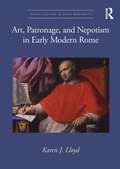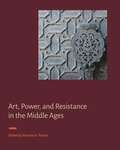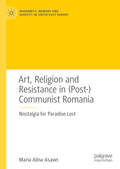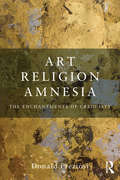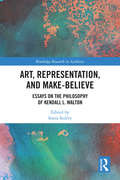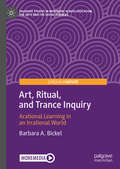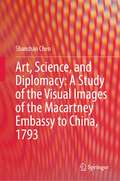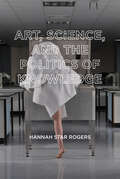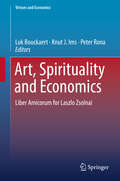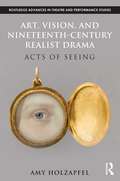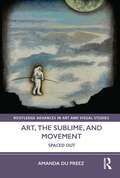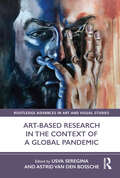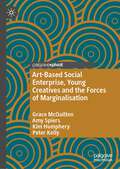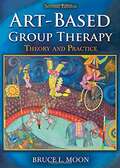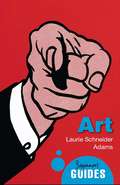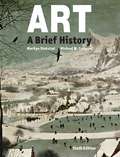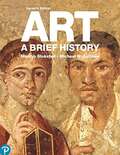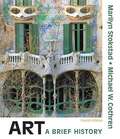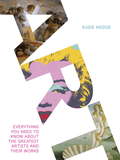- Table View
- List View
Art, Passion & Power: The Story of the Royal Collection
by Michael Hall"Hall’s consummate history is not just the story of the evolution of one of the world’s great collections… The book is also a through-the-keyhole insight into the shifting tastes, good or bad, of 1,000 years of monarchs."- The TimesThe Royal Collection is the last great collection formed by the European monarchies to have survived into the twenty-first century. Containing over a million artworks and objects, it covers all aspects of the fine and decorative arts, from paintings by Rembrandt and Michelangelo to grand sculpture, Fabergé eggs and some of the most exquisite furniture ever made. The Royal Collection also offers a revealing insight into the history of the British monarchy from William the Conqueror to Queen Elizabeth II, recording the tastes and obsessions of kings and queens over the past 500 years. With unprecedented access to the royal residences of St James' Palace, Windsor Castle and Buckingham Palace, Art, Passion & Power traces the history of this national institution from the Middle Ages to the present day, exploring how royalty used the arts to strengthen their position as rulers by divine right and celebrating treasures from the Crown Jewels to the "Abraham" tapestries in Hampton Court Palace. Author Michael Hall examines the monarchy's response to changing attitudes to the arts and sciences during the Enlightenment and celebrates the British monarchy's role in the democratisation of art in the modern world. Packed with glimpses of rarely seen artworks, Art, Passion & Power is a visual treat for all art enthusiasts. Accompanying the BBC television series and a major exhibition at the Royal Academy, Art, Passion & Power is the definitive statement on the British monarchy's treasures of the art world.
Art, Patronage, and Nepotism in Early Modern Rome (Visual Culture in Early Modernity)
by Karen J. LloydDrawing on rich archival research and focusing on works by leading artists including Guido Reni and Gian Lorenzo Bernini, Karen J. Lloyd demonstrates that cardinal nephews in seventeenth-century Rome – those nephews who were raised to the cardinalate as princes of the Church – used the arts to cultivate more than splendid social status. Through politically savvy frescos and emotionally evocative displays of paintings, sculptures, and curiosities, cardinal nephews aimed to define nepotism as good Catholic rule. Their commissions took advantage of their unique position close to the pope, embedding the defense of their role into the physical fabric of authority, from the storied vaults of the Vatican Palace to the sensuous garden villas that fused business and pleasure in the Eternal City. This book uncovers how cardinal nephews crafted a seductively potent dialogue on the nature of power, fuelling the development of innovative visual forms that championed themselves as the indispensable heart of papal politics. The book will be of interest to scholars working in art history, early modern studies, religious history, and political history.
Art, Power, and Resistance in the Middle Ages (Signa: Papers of the Index of Medieval Art at Princeton University)
by Pamela A. PattonThis volume addresses a vital point of intersection between images in the Middle Ages and those in the modern world: the potential of medieval works of art to convey messages of power and resistance. Provoked by the misuse of medieval imagery in modern discussions, the contributors to this volume assess how medieval images connect to discourses of power in both the past and the present.The contributors each began with a single question: In the eyes of their makers and viewers, how were medieval images understood to assert or to resist forces of power? Their case studies come from a wide range of cultural, geographic, and historical contexts: the Byzantine, Ottonian, and Valois courts; the Umayyad and Castilian regimes of the Iberian Peninsula; the pluralistic military and commercial zones of the eastern Mediterranean; and the metaphorical as well as personal battlegrounds linked to medieval “courtly love” culture. Over eight chapters, the authors highlight patterns of visual rhetoric still evident in art today. They invite readers to contemplate how modern priorities and sensibilities might amplify, mute, or transform the discourses related to power and resistance that were threaded through the visual culture of the Middle Ages.This insightful book should be of value to anyone interested in medieval art history and art’s relationship to power and authority in society.In addition to the editor, the contributors include Heather A. Badamo, Elena N. Boeck, Thomas E. A. Dale, Martha Easton, Eliza Garrison, Anne D. Hedeman, Tom Nickson, and Avinoam Shalem.
Art, Religion and Resistance in: Nostalgia for Paradise Lost (Modernity, Memory and Identity in South-East Europe)
by Maria Alina AsaveiThis book illuminates the interconnections between politics and religion through the lens of artistic production, exploring how art inspired by religion functioned as a form of resistance, directed against both Romanian national communism (1960-1989) and, latterly, consumerist society and its global market. It investigates the critical, tactical and subversive employments of religious motifs and themes in contemporary art pieces that confront the religious ‘affair’ in post-communist Romania. In doing so, it addresses a key gap in previous scholarship, which has paid little attention to the relationship between religious art and political resistance in communist Central and South-East Europe.
Art, Religion, Amnesia: The Enchantments of Credulity
by Donald PreziosiArt, Religion, Amnesia addresses the relationship between art and religion in contemporary culture, directly challenging contemporary notions of art and religion as distinct social phenomena and explaining how such Western terms represent alternative and even antithetical modes of world-making. In this new book, Professor Preziosi offers a critique of the main thrust of writing in recent years on the subjects of art, religion, and their interconnections, outlining in detail a perspective which redefines the basic terms in which recent debates and discussions have been articulated both in the scholarly and popular literature, and in artistic, political and religious practice. Art, Religion and Amnesia proposes an alternative to the two conventional traditions of writing on the subject which have been devoted on the one hand to the ‘spiritual’ dimensions of artistry, and on the other hand to the (equally spurious) ‘aesthetic’ aspects of religion. The book interrogates the fundamental assumptions fuelling many current controversies over representation, idolatry, blasphemy, and political culture. Drawing on debates from Plato’s proposal to banish representational art from his ideal city-state to the Danish cartoons of Mohamed, Preziosi argues that recent debates have echoed a number of very ancient controversies in political philosophy, theology, and art history over the problem of representation and its functions in individual and social life. This book is a unique re-evaluation of the essential indeterminacy of meaning-making, marking a radically new approach to understanding the inextricability of aesthetics and theology and will be of interest to students and researchers in art history, philosophy and religion and cultural theory.
Art, Representation, and Make-Believe: Essays on the Philosophy of Kendall L. Walton (Routledge Research in Aesthetics)
by Sonia SedivyThis is the first collection of essays focused on the many-faceted work of Kendall L. Walton. Walton has shaped debate about the arts for the last 50 years. He provides a comprehensive framework for understanding arts in terms of the human capacity of make-believe that shows how different arts – visual, photographic, musical, literary, or poetic – can be explained in terms of complex structures of pretense, perception, imagining, empathy, and emotion. His groundbreaking work has been taken beyond aesthetics to address foundational issues concerning linguistic and scientific representations – for example, about the nature of scientific modelling or to explain how much of what we say is quite different from the literal meanings of our words. Contributions from a diverse group of philosophers probe Walton’s detailed proposals and the themes for research they open. The essays provide an overview of important debates that have Walton’s work at their core. This book will be of interest to scholars and graduate students working on aesthetics across the humanities, as well as those interested in the topic of representation and its intersection with perception, language, science, and metaphysics.
Art, Ritual, and Trance Inquiry: Arational Learning in an Irrational World (Palgrave Studies in Movement across Education, the Arts and the Social Sciences)
by Barbara A. BickelThis book provides insights into the practice of trance-based inquiry through arts-based research, serving as a beacon to guide the way to thresholds of ancient, yet novel, transmissions. Embedded in lived experience and theory, this book introduces the reader to the liminal space of place and trance-based inquiry processes entwined with creative artworkings. The interweaving of art, ritual, and trance-based inquiry opens sacred spaces for learning and unlearning that bring spirit into form. Each chapter presents examples from women artists and culminates with experiential practices drawn from the author’s decades of creative peregrinations to assist artists, teachers, and researchers in transmitting a conscious way of practicing and creating with trance.
Art, Science, and Diplomacy: A Study of the Visual Images of the Macartney Embassy to China, 1793
by Shanshan ChenThis book examines how the Embassy members approached, selected, and represented information, and how, in doing so, they helped to shape European perceptions of China. The Macartney Embassy of 1793 was the first British diplomatic mission to China, seeking to open ties between the two empires. As part of the mission, the British government commissioned writers and artists to chronicle the geography and culture of a civilization that had, until then, been shrouded in mystery. A central focus of the book is the artwork itself, which provides a window into the diplomatic, artistic and scientific viewpoints underlying the mission. Drawing on archival research, the study recreates the processes through which the Embassy’s draughtsmen, scientists, and diplomats collaborated to represent the visual images, and how the materials were reworked for publication in London. The finished product demonstrates that the artists offered a distinct viewpoint in the representation of China, sometimes differing from the textual accounts, by blending scientific elements and artistic aesthetics in order to demystify China and make it more knowable to a British audience. It was in the interposition of text and image that the British public formulated an ambivalent perception of China that embraced both admiration and disdain. In addition to the scholars, the book targets general readers who are interested in global art and history, and East–West interactions. It contains important images with detailed visual and historical analysis that enable readers to acquire knowledge on how the British represented China and how that image helped to shape the European perception of China during the British global expansion in the eighteenth and nineteenth centuries, and beyond.
Art, Science, and the Politics of Knowledge
by Hannah Star RogersHow the tools of STS can be used to understand art and science and the practices of these knowledge-making communities.In Art, Science, and the Politics of Knowledge, Hannah Star Rogers suggests that art and science are not as different from each other as we might assume. She shows how the tools of science and technology studies (STS) can be applied to artistic practice, offering new ways of thinking about people and objects that have largely fallen outside the scope of STS research. Arguing that the categories of art and science are labels with specific powers to order social worlds—and that art and science are best understood as networks that produce knowledge—Rogers shows, through a series of cases, the similarities and overlapping practices of these knowledge communities. The cases, which range from nineteenth-century artisans to contemporary bioartists, illustrate how art can provide the basis for a new subdiscipline called art, science, and technology studies (ASTS), offering hybrid tools for investigating art–science collaborations. Rogers&’s subjects include the work of father and son glassblowers, the Blaschkas, whose glass models, produced in the nineteenth century for use in biological classification, are now displayed as works of art; the physics photographs of documentary photographer Berenice Abbott; and a bioart lab that produces work functioning as both artwork and scientific output. Finally, Rogers, an STS scholar and contemporary art–science curator, draws on her own work to consider the concept of curation as a form of critical analysis.
Art, Spirituality and Economics: Liber Amicorum for Laszlo Zsolnai (Virtues and Economics #2)
by Luk Bouckaert Peter Rona Knut J. ImsThis volume celebrates the work of Laszlo Zsolnai, a leading researcher and scholar in the field of the ethical and spiritual aspects of economic life, who has made significant contributions to the connection between ethics, spirituality, aesthetics and economic theory. <P><P>The book offers a selection of essays concerned with the ethical, spiritual and aesthetic context within which economics as a social studies discipline should be situated in order to avoid the sort of dehumanising consequences that theories based on utility maximisation and rational choice necessarily entail. It presents the economic activities of human beings not as some sort of preordained obedience to universal laws that operate independently of other human concerns, but, rather, as a part of the human desire for the Aristotelian good life. It looks at the various considerations –moral, spiritual and aesthetic – that take part in the formation of economic decisions in sharp contrast with theories that purport to explain economic phenomena solely on the basis of utility maximisation.
Art, Vision, and Nineteenth-Century Realist Drama: Acts of Seeing (Routledge Advances in Theatre & Performance Studies)
by Amy HolzapfelRealism in theatre is traditionally defined as a mere seed of modernism, a crude attempt to reproduce an exact copy of reality on stage. Art, Vision & Nineteenth-Century Realist Drama redefines realism as a complex and under-examined form of visual modernism, one that positioned theatre at the crux of the encounter between consciousness and the visible world. Tracing a historical continuum of "acts of seeing" on the realist stage, Holzapfel demonstrates how theatre participated in modernity’s aggressive interrogation of vision’s residence in the human body. New findings by scientists and philosophers—such as Diderot, Goethe, Müller, Helmholtz, and Galton—exposed how the visible world is experienced and framed by the unstable relativism of the physiological body rather than the fixed idealism of the mind. Realist artists across media paradoxically embraced this paradigm shift by focusing on the embodied observer. Drawing from extensive archival research, Holzapfel conducts close readings of iconic dramas and their productions—including Scribe’s The Glass of Water, Zola’s Thérèse Raquin, Ibsen’s A Doll House, Strindberg’s The Father, and Hauptmann’s Before Sunrise—alongside analyses of artwork by major painters and photographers—such as Chardin, Nadar, Millais, Rejlander, and Liebermann. In a radical challenge to existing criticism, Holzapfel argues that realism in theatre was never the attempt to reproduce an exact copy of the seen world but rather the struggle to make visible the act of seeing.
Art, the Sublime, and Movement: Spaced Out (Routledge Advances in Art and Visual Studies)
by Amanda du PreezThis book is a critical interdisciplinary approach to the study of contemporary visual culture and image studies, exploring ideas about space and place and ultimately contributing to the debates about being human in the digital age. The upward and downward pull seem in a constant contest for humanity’s attention. Both forces are powerful in the effects and affects they invoke. When tracing this iconological history, Amanda du Preez starts in the early nineteenth century, moving into the twentieth century and then spanning the whole century up to contemporary twenty-first century screen culture and space travels. Du Preez parses the intersecting pathways between Heaven and Earth, up and down, flying and falling through the concept of being “spaced out”. The idea of being “spaced out” is applied as a metaphor to trace the visual history of sublime encounters that displace Earth, gravity, locality, belonging, home, real life, and embodiment. The book will be of interest to scholars working in art history, visual culture, media and cultural studies, phenomenology, digital culture, mobility studies, and urban studies.
Art, the Sublime, and Movement: Spaced Out (Routledge Advances in Art and Visual Studies)
by Amanda du PreezThis book is a critical interdisciplinary approach to the study of contemporary visual culture and image studies, exploring ideas about space and place and ultimately contributing to the debates about being human in the digital age. The upward and downward pull seem in a constant contest for humanity’s attention. Both forces are powerful in the effects and affects they invoke. When tracing this iconological history, Amanda du Preez starts in the early nineteenth century, moving into the twentieth century and then spanning the whole century up to contemporary twenty-first century screen culture and space travels. Du Preez parses the intersecting pathways between Heaven and Earth, up and down, flying and falling through the concept of being “spaced out”. The idea of being “spaced out” is applied as a metaphor to trace the visual history of sublime encounters that displace Earth, gravity, locality, belonging, home, real life, and embodiment. The book will be of interest to scholars working in art history, visual culture, media and cultural studies, phenomenology, digital culture, mobility studies, and urban studies.
Art-Based Research
by Shaun McniffArt therapy and all of the other creative arts therapies have promoted themselves as ways of expressing what cannot be conveyed in conventional language. Why is it that creative arts therapists fail to apply this line of thinking to research? In this exciting and innovative book, Shaun McNiff, one of the field's pioneering educators and authors, breaks new ground in defining and inspiring art-based research. He illustrates how practitioner-researchers can become involved in art-based inquiries during their educational studies and throughout their careers, and shows how new types of research can be created that resonate with the artistic process. Clearly and cogently expressed, the theoretical arguments are illustrated by numerous case examples, and the final part of the book provides a wealth of ideas and thought provoking questions for research. This challenging book will prove invaluable to creative art therapy educators, students, and clinicians who wish to approach artistic inquiry as a way of conducting research. It will also find a receptive audience within the larger research community where there is a rising commitment to expanding the theory and practice of research. Integrating artistic and scientific procedures in many novel ways, this book offers fresh and productive visions of what research can be.
Art-Based Research in the Context of a Global Pandemic (Routledge Advances in Art and Visual Studies)
by Usva Seregina Van den Bossche, AstridLiving through the Covid-19 global pandemic has changed the way that we experience our lives, the way that we relate to one-another, and the way that we engage with the world. Focusing contextually on the initial lockdowns of the pandemic in 2020, this book proposes that art-based research has a central, illuminative role to play in our understanding of unfolding crises. The changes brought on by the global event may not be readily accessible or expressible through traditional academic research. Art-based research offers the opportunity to explore, document, and reflect on the emerging and often ineffable qualities of transformed lives by drawing on emotional, bodily, and interactive aspects of experience. Such an approach allows for meaning-making that makes room for reflexive, interpersonal, and dialogical engagement. The contributions aim to capture and explore lived experiences of the pandemic, as well as begin a discussion about how meaning-making is changing through and beyond the pandemic. This book further explores how the nature and practice of art-based research in itself has been challenged and transformed. The book will be of interest to scholars working in art education, art psychotherapy, consumer research, visual studies, cultural studies, and sociology.
Art-Based Social Enterprise, Young Creatives and the Forces of Marginalisation
by Peter Kelly Kim Humphery Grace McQuilten Amy SpiersThis book analyses the challenges and opportunities faced by art-based social enterprises (ASEs) engaging young creatives in education and training and supporting their pathways to the creative industries. In doing so, it addresses the complex intersecting issues of marginality and entrepreneurship, particularly in relation to young creatives from socially, economically and culturally diverse backgrounds. Drawing on extensive fieldwork and interviews with twelve key organisations, and three in-depth case studies in Australia, the book offers a detailed analysis of using enterprise to engage with the structural challenges of marginality. The book explores the local and global contexts through which art-based social enterprises (ASEs) operate and within which they attempt – often successfully – to improve access to education and work for emerging creatives. It also attends to the findings generated through engaging with the lived experiences of the staff and young creatives involved in our ASE case studies, in order to understand both the challenges and impacts of the ASE model on young people’s education, training, and employment pathways. The book focuses on three broad themes; precarious youth and digital futures, material practice and sustainable economies, and cultural citizenship in the urban fringe. In exploring these themes, the book contributes to debates about the limits, possibilities and challenges that attach to, and emerge from, an ASE model and highlights the ways in which these models can contribute to young people’s well-being, engagement, education and training, and work pathways. More broadly, it examines the possibilities of art as a means of social and cultural engagement. In the context of the precarious future of the creative industries, this book emphasise the ways in which young artists are building alternative economic and cultural models that support both individual pathways and collective change. This book will move the field forward with a critical lens that engages closely with experience and the lived realities of juggling multiple priorities of social, economic and artistic goals.
Art-based Group Therapy: Theory And Practice
by Bruce L. MoonIn this second edition Moon provides essential principles regarding art-based therapy groups. The book is intended for art therapy students and practitioners, offering philosophic and practical information related to the use of art in a host of group therapy contexts.
Art-based Group Therapy: Theory and Practice
by Bruce L. MoonPerhaps more than ever before, today's art therapists are being encouraged to apply their knowledge base to the development of strategies for community building, and art-based approaches to preventing and treating emotional problems. In many settings, individual counseling or psychotherapy is no longer financially feasible. Art-based group therapy allows art therapists to work with many more clients than would be possible in individual sessions. Moreover, art-based group process also has unique qualities that can often serve as the treatment of choice for many clients.
Art: A Beginner's Guide (Beginner's Guides)
by Laurie Schneider AdamsArt has existed for as long as humankind, but defining it is notoriously difficult. In this whirlwind tour spanning from prehistory up to the present day and beyond, Laurie Schneider Adams explores how art and our views on it have evolved. Delving into fascinating issues such as why some artworks can be so controversial, why a forgery can never be as "good" as the original, and what the future of art may hold, this beautifully crafted introduction provides a deft overview of Western artistic tradition. Also providing a helpful guide to understanding art terminology and to reading artworks for meaning, Art: A Beginner's Guide is an essential tool for every budding art critic. Laurie Schneider Adams is Professor of Art at John Jay College, City University of New York. She is the author of A History of Western Art and Looking at Art, and is Editor-in-Chief of the journal Source: Notes in the History of Art.
Art: A Brief History
by Marilyn Stokstad Michael W. CothrenFor Art History Survey courses The most student-friendly, contextual, and inclusive art history survey text on the market Now in its sixth edition, Art: A Brief History continues to balance formal analysis with contextual art history in order to engage a diverse student audience. Authors Marilyn Stokstad and Michael Cothren, both scholars as well as teachers, share a common vision that survey courses should be filled with as much enjoyment as learning, and that they should foster an enthusiastic, as well as an educated, public for the visual arts. By treating the visual arts as one component of a vibrant cultural landscape (which also includes politics, religion, economics, and more), Art: A Brief History helps students recognize and appreciate the central role that art and architecture have played in human history.
Art: A Brief History
by Marilyn Stokstad Michael CothrenFor courses in Art History Survey A welcoming, inclusive, engaging, and global approach to art Revel™ Art: A Brief Historybrings the history of art to life for a new generation of students. The concise version of Stokstad and Cothren’s Art History is global in scope, inclusive in its coverage, and warm and welcoming in tone. The guiding vision of the text is that the teaching of art history survey courses should be filled with equal delight, enjoyment, and serious learning, while fostering an enthusiastic and educated public for the visual arts. The 7th Edition has been revised to reflect new discoveries, recent research, and fresh interpretive perspectives, as well as to address the changing needs of both students and educators.
Art: A Brief History (4th edition)
by Marilyn Stokstad Michael W. CothrenThis book features excellent scholarship, takes a global approach with an emphasis on the Western tradition in art. It reflects new interests and issues, expanding the topic to include women and minorities, and showing media and techniques other than painting, sculpture, and architecture. This book serves as an introduction to the history of art and a ready reference for people working in the arts, including museum docents, and art gallery employees, owners, and managers.
Art: Conversations with Paul Gsell (Quantum Books)
by Auguste RodinThis title is part of UC Press's Voices Revived program, which commemorates University of California Press’s mission to seek out and cultivate the brightest minds and give them voice, reach, and impact. Drawing on a backlist dating to 1893, Voices Revived makes high-quality, peer-reviewed scholarship accessible once again using print-on-demand technology. This title was originally published in 1984.
Art: Everything You Need to Know About the Greatest Artists and Their Works
by Susie HodgeArt introduces readers to 100 of the world's most important artists and their paintings, from the 13th century to the modern era. Works by artists including Caravaggio, Vermeer, van Gogh and Warhol are reproduced in superb high quality, arranged chronologically and set in their historical context by Susie Hodge's concise and readable narrative. Including explanations of key periods in art history - from the Early Renaissance to Dutch Realism, and from Rococo to Pop Art - a guide to the world's best art galleries and a helpful glossary of key terms, this is the perfect book for any art lover.
Art: Everything You Need to Know About the Greatest Artists and Their Works
by Susie HodgeArt introduces readers to 100 of the world's most important artists and their paintings, from the 13th century to the modern era. Works by artists including Caravaggio, Vermeer, van Gogh and Warhol are reproduced in superb high quality, arranged chronologically and set in their historical context by Susie Hodge's concise and readable narrative. Including explanations of key periods in art history - from the Early Renaissance to Dutch Realism, and from Rococo to Pop Art - a guide to the world's best art galleries and a helpful glossary of key terms, this is the perfect book for any art lover.

